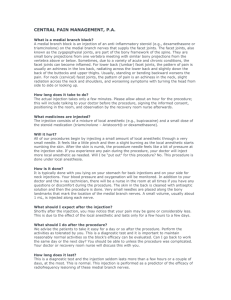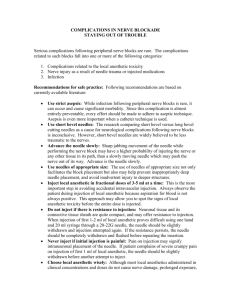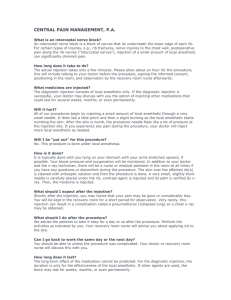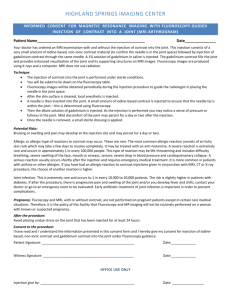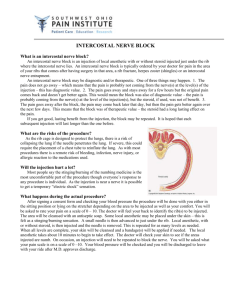Injection Educational Handouts
advertisement
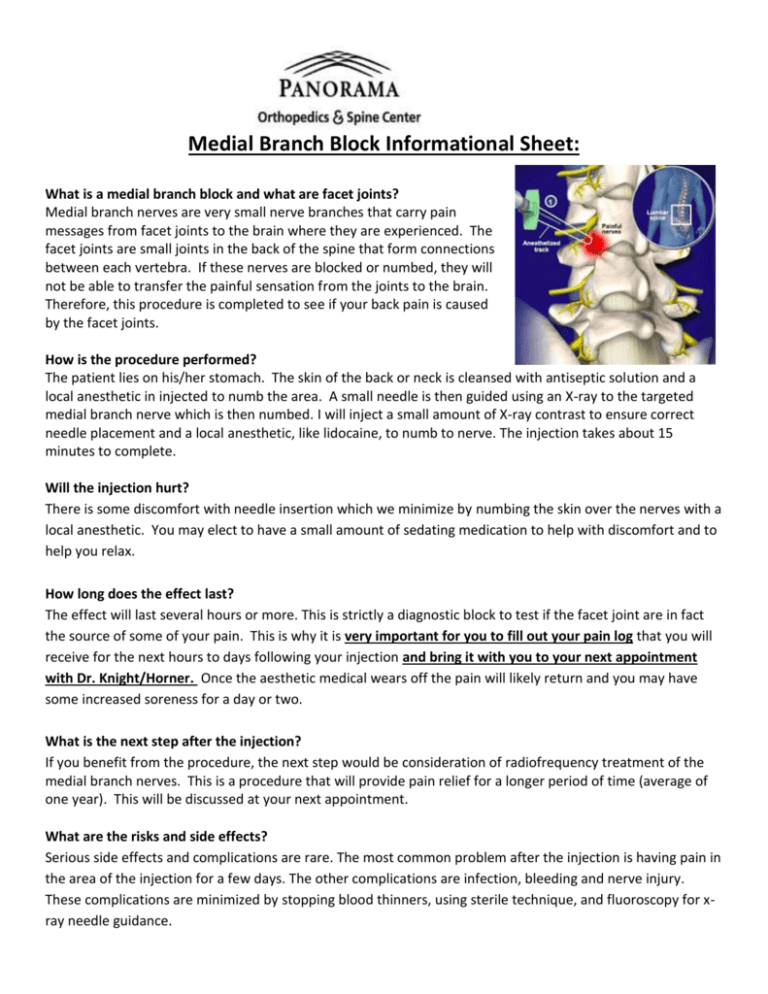
Medial Branch Block Informational Sheet: What is a medial branch block and what are facet joints? Medial branch nerves are very small nerve branches that carry pain messages from facet joints to the brain where they are experienced. The facet joints are small joints in the back of the spine that form connections between each vertebra. If these nerves are blocked or numbed, they will not be able to transfer the painful sensation from the joints to the brain. Therefore, this procedure is completed to see if your back pain is caused by the facet joints. How is the procedure performed? The patient lies on his/her stomach. The skin of the back or neck is cleansed with antiseptic solution and a local anesthetic in injected to numb the area. A small needle is then guided using an X-ray to the targeted medial branch nerve which is then numbed. I will inject a small amount of X-ray contrast to ensure correct needle placement and a local anesthetic, like lidocaine, to numb to nerve. The injection takes about 15 minutes to complete. Will the injection hurt? There is some discomfort with needle insertion which we minimize by numbing the skin over the nerves with a local anesthetic. You may elect to have a small amount of sedating medication to help with discomfort and to help you relax. How long does the effect last? The effect will last several hours or more. This is strictly a diagnostic block to test if the facet joint are in fact the source of some of your pain. This is why it is very important for you to fill out your pain log that you will receive for the next hours to days following your injection and bring it with you to your next appointment with Dr. Knight/Horner. Once the aesthetic medical wears off the pain will likely return and you may have some increased soreness for a day or two. What is the next step after the injection? If you benefit from the procedure, the next step would be consideration of radiofrequency treatment of the medial branch nerves. This is a procedure that will provide pain relief for a longer period of time (average of one year). This will be discussed at your next appointment. What are the risks and side effects? Serious side effects and complications are rare. The most common problem after the injection is having pain in the area of the injection for a few days. The other complications are infection, bleeding and nerve injury. These complications are minimized by stopping blood thinners, using sterile technique, and fluoroscopy for xray needle guidance. Sacroiliac Joint Injection Informational Sheet: What is sacroiliac joint dysfunction? Sacroiliac joint dysfunction is an injury or inflammation of the sacroiliac (SI) joint which causes pain in the lower back region. The SI joint is formed by the connection of the sacrum with ilium. What is a sacroiliac joint injection and how is it performed? This injection is used to both diagnose and treat your low back pain caused by inflammation of the joint. To perform the injection, the patient lies on her/his stomach. The skin is cleansed with antiseptic solution and numbed with a local anesthetic. Using X-ray guidance, a needle is inserted into the SI joint. To ensure the needle is in the joint, a small amount of dye is injected to confirm placement. Once the needle is in the correct location a mixture of numbing medication and steroid is injected. This procedure usually takes 10 minutes to complete. Will the injection hurt? There is some discomfort with needle insertion which we minimize by numbing the skin over the join with a local anesthetic. You may elect to have a small amount of sedating medication to help with discomfort and to help you relax. How long does the effect last? The effect might last a few hours to a few weeks or much longer. Pain relief in the first couple of hours after the injection is the most important as this tells us our diagnosis of SI joint mediated pain is correct. If the symptoms do return, we will discuss other options available for extended pain relief. What is the next step after the injection? You will be given a pain log to complete after the procedure. This will help us to measure your response to the injection and determine the next most appropriate plan of care. Please bring your pain log with you to your follow up appointment with Dr. Knight/Horner. What are the risks and side effects? Serious side effects and complications are rare. The most common problem after the injection is having pain in the area of the injection for a few days. The other complications are infection, bleeding and nerve injury. These complications are minimized by stopping blood thinners, using sterile technique, and fluoroscopy for xray needle guidance. Facet Joint Injection Informational Sheet: What are facet joints? The facet joints are small joints in the back of the spine that form connections between each vertebra. If these joints are blocked or numbed, they will not be able to transfer the painful sensation to the brain. Therefore, this procedure is completed to see if your back pain is caused by the facet joints. How is the procedure performed? The patient lies on his/her stomach. The skin of the back or neck is cleansed with antiseptic solution and a local anesthetic in injected to numb the area. A small needle is then guided using an X-ray to the targeted facet joints which are then numbed. I may inject a small amount of X-ray contrast to ensure correct needle placement. An anesthetic and steroid is then injected into the joint. The injection takes about 15 minutes to complete. Will the injection hurt? There is some discomfort with needle insertion which we minimize by numbing the skin over the joint with a local anesthetic. You may elect to have a small amount of sedating medication to help with discomfort and to help you relax. How long does the effect last? The effect might last a few hours to a few weeks or much longer. Pain relief in the first couple of hours after the injection is the most important as this tells us our diagnosis of facet joint mediated pain is correct. If the symptoms do return, we will discuss other options available for extended pain relief, such a radiofrequency. What is the next step after the injection? You will be given a pain log to complete after the procedure. This will help us to measure your response to the injection and determine the next most appropriate plan of care. Please bring your pain log with you to your follow up appointment with Dr. Knight/Horner. What are the risks and side effects? Serious side effects and complications are rare. The most common problem after the injection is having pain in the area of the injection for a few days. The other complications are infection, bleeding and nerve injury. These complications are minimized by stopping blood thinners, using sterile technique, and fluoroscopy for xray needle guidance. Epidural Steroid Injection Informational Sheet: What is an epidural steroid injection? An epidural injection is an injection of steroid into the epidural space. The epidural space is a space located in the spine between the vertebrae and the dural sac, which surrounds the spinal cord. Theoretically, the steroid reduces the inflammation of the nerve roots as they exit the spine, which can help alleviate pain in the neck, back, and/or limbs. How is the injection preformed? The patient lies on his/her stomach and the skin on the back or neck is cleansed with an antiseptic solution. The skin and deeper tissues are numbed with an anesthetic using a small needle and once the skin is numb, an X-ray machine helps guide the needle into the epidural space. Once the epidural space is entered, X-ray contract is injected to ensure correct positioning of the needle, then medication consisting of a numbing medicine and a steroid (dexamethasone or celestone) will be injected. The procedure takes approximately 15 minutes. Will the injection hurt? There is some discomfort with needle insertion which we minimize by numbing the skin over the joint with a local anesthetic. You may elect to have a small amount of sedating medication to help with discomfort and to help you relax. How long does the effect last? The effect might last a few hours to a few weeks or much longer. Pain relief in the first couple of hours after the injection is the most important as this tells us our diagnosis is likely correct. If the symptoms do return, we will discuss options available for continued pain relief, which may include repeating the injection for additive benefit. What is the next step after the injection? You will be given a pain log to complete after the procedure. This will help us to measure your response to the injection and determine the next most appropriate plan of care. Please bring your pain log with you to your follow up appointment with Dr. Knight/Horner. What are the risks and side effects? Serious side effects and complications are rare. The most common problem after the injection is having pain in the area of the injection for a few days. The other complications are infection, bleeding and nerve injury. These complications are minimized by stopping blood thinners, using sterile technique, and fluoroscopy for xray needle guidance. Radiofrequency Ablation Information Sheet What is radiofrequency ablation (RFA) and why is it performed? Radiofrequency Ablation is an injection that uses a specialized machine that generates radiofrequency current. The current is then passed through a special needle placed next to the nerve (medial branch) which carries pain form the facet joints to the spinal cord. The current generates heat or other physical forces which interrupts transmission of pain. Radiofrequency ablation is preformed after the patient has benefitted from a diagnostic medial branch nerve blocks. How is the procedure performed? The procedure is performed under x-ray with the patient lying on his/her stomach. The skin is cleansed with an antiseptic solution and then anesthetized with a numbing medication. After the skin is numb, needles are places near the target nerve under x-ray guidance. The nerve will then be numbed prior to starting the radiofrequency ablation. It is typical for 3 nerves to be targeted, so there are usually 3 injections performed during this procedure. Will the injection hurt? There is some discomfort with needle insertion which we minimize by numbing the skin over the joint with a local anesthetic. You may elect to have a small amount of sedating medication to help with discomfort and to help you relax. How long does the effect last? The effect will hopefully last for an extended period of time (one year on average). You will likely experience some increase in your neck or back pain over the next several days and then your pain should improve. What is the next step after the injection? You will be given a pain log to complete after the procedure. This will help us to measure your response to the injection and determine the next most appropriate plan of care. Please bring your pain log with you to your follow up appointment with Dr. Knight/Horner. What are the risks and side effects? Serious side effects and complications are rare. The most common problem after the injection is having pain in the area of the injection for a few days. The other complications are infection, bleeding and nerve injury. These complications are minimized by stopping blood thinners, using sterile technique, and fluoroscopy for xray needle guidance.
